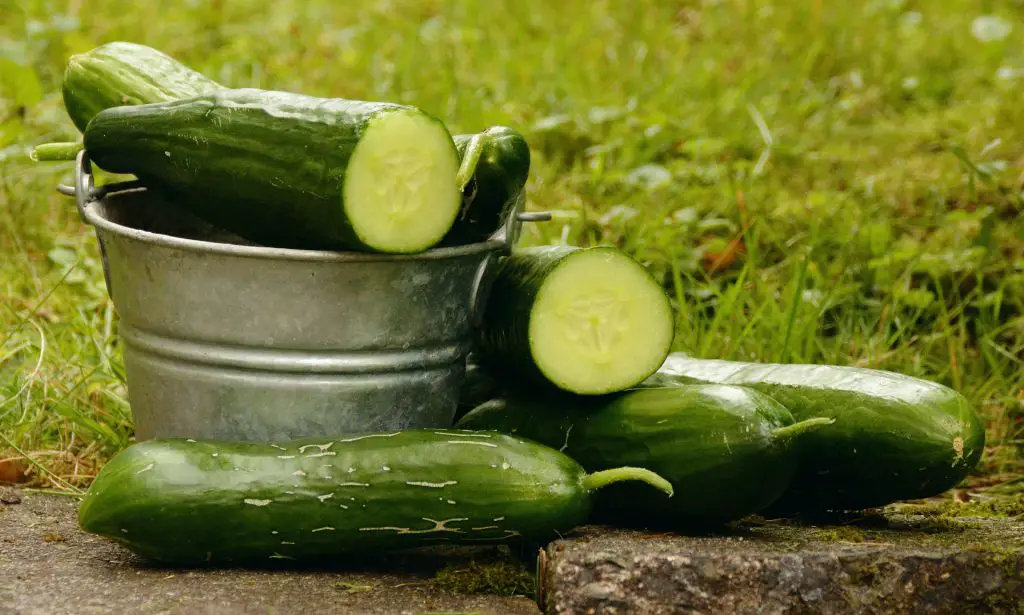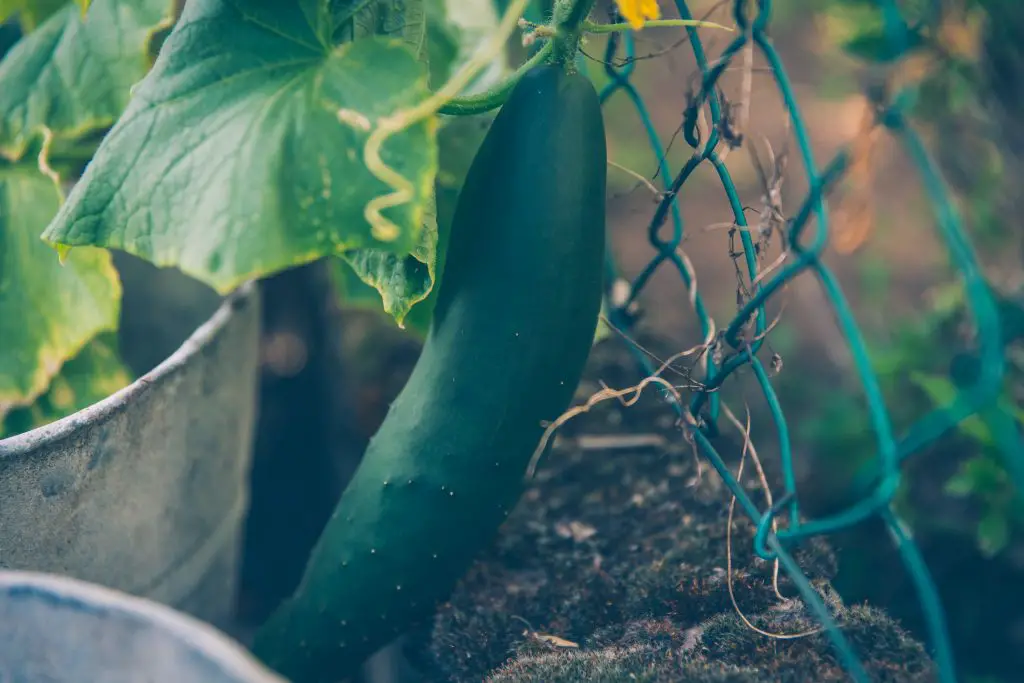How Many Cucumbers Grow In A Container? Cucumbers are an extremely popular plant to grow at home in your own yard. They are ideally suited to growing in containers due to there ability to climb a trellis which reduces the space needed to grow them. However, it is difficult to know how many Cucumbers to plant in container to get the maximum output?
Based on a study by North Carolina State University the optimum planting density is approximately one plant for every 12 litres (3 gallons) of soil in containers. Having additional space for a plant does not appear to increase the yield further while increasing the density of plant in all cases reduces the output of individual plants however this reduction is offset by an increase in the number of plants in the container.
These findings appear to be reasonably consistent irrespective of the type of Cucumber grown (Slicing Vs Pickling), its growing habit (dwarf Vs taller varieties) and its physiology (Monoecious Vs Gynoecious).
Cucumbers can be classified into 3 distinct varieties based on their physiology, Monoecious, Gynoecious and Parthenocarpic.
Monoecious plants are varieties that produce both male and female flowers on the plant in roughly equal numbers. This characteristic ensures that the plant is self pollinating, however, the plants do not necessarily produce the flowers at the same which can mean that the pollination can be problematic in some cases. The male flowers to appear first, usually a week or two prior to the female flowers appearing.
Gynoecious plants generally produce a majority of female flowers on the plant. The primary advantage of these types of Cucumbers, is that it produces more female flowers, which provides an opportunity to get a higher yield per plant. However, this outcome is really not observed in the North Carolina State University study.
The disadvantage of Gynoecious varieties is that it requires a second variety for pollination, as there are a limited number of male flowers present on the plant.

Parthenocarpic varieties, which where not included in the study, are Cucumbers that can produce fruit without the need for pollination. This is extremely advantageous characteristic when growing fruit in the greenhouse. However, as there is no pollination that occurs no seeds are produced which does not allow seeds to be saved for the following year.
How Does The Increasing The Number Of Plants In A Container Affect Yield?
To assess the impact of changing the density of planting in a container on yield researchers from North Carolina State University assessed the impact of planting 1, 2 or 3 plants in a 12 litre (3 gallon container). There were 14 varieties include in the study, 6 slicing and 8 pickling varieties.
Slicing Varieties
The results in the trial indicated that the increasing the density of planting within the container from 1 to 3 in all cases increased the overall yield per container though the increase was relatively modest for taller varieties.
However, in all cases the yield per plant reduced as the density increased. The only variety that provided a similar yield when the plant density increased by 1 to 2 in the container was Blue Champion. See the graph below for results.

In the case of the taller varieties Bush Whopper II, Dasher II and Marketmore 76, the addition of one plant to the container generally resulted in a reduction in yield of around 45% per plant. This provided only a slight improvement in yield for the overall container of around 10%. This suggests there is limited value in adding additional plants to the 12 litre (3 gallon) container.
Unfortunately, the study did not extend to increasing the volume of the container to a size larger than 12 litres (3 gallons). However, when comparing these results with a Cornell University trial in which Cucumbers were grown in the ground rather in a container it is observed that the yield for a single plant in a container is similar to plants grown in the ground.
This suggests that a container 12 litres (3 gallons) in size would be optimal for a single plant and minimal benefit would be gained by having a larger container unless more than one plant was to be grown in it.
Pickling Varieties
The smaller pickling varieties like the slicing varieties showed an overall increase in the yield in most cases when additional plants were added to the containers. The extent of this improvement was generally greater that the slicing varieties even though the yield of the individual plants fell as the density of the plants rose. However, unlike the slicing varieties the dwarf varieties did not fair better than the tall varieties.

Growing Cucumbers In Containers
When growing Cucumbers in containers we recommend using a container that is at least 24 litres (6 gallons) in size rather than using a 12 litre (3 gallon) container. The reason for this is because it will allow two plants to be planted in the container providing and opportunity to use either Monoecious or Gynoecious varieties. Additionally, I also like to have at least two plants of any crop incase there is a failure.
An alternative way to manage this is to initially plant more cucumbers in the container than you intend to keep and remove the weakest plants once they are established.
The other reason for using a large container is that they have capacity to hold moisture for a longer period reducing the frequency of watering required. Water holding capacity can also be improved by using Hydrogels (water crystals) in the soil. To read about how effective they are and how to use them click here.
The container we recommend using is the Victory 8 Modular Fabric Pot which is shown in the picture below. The reason for this is because the containers are relatively low cost, they have a relatively high volume, approximately 8 gallons and they are more space efficient than round pots because they can be packed together closely. They are also really convenient if you are doing square foot gardening, as each container is 1 square foot.

Cucumbers are a frost sensitive plant that requires warm temperatures to thrive. When starting the Cucumber plants off it is best to sow the seed indoors early in Spring to ensure that you have the earliest possible harvest in Summer. The seeds should be sown at a depth of 1 to 2 cm (0.5 inches) with one seed per cell. When planting seeds always plant 25% to 50% more seeds that you require for the garden to ensure you have plenty of seedlings to plant.
The variety we would recommend plant is the Spacemaster as it is a dwarf variety that performed well in containers even when the planting density was higher than the optimal 12 litres (3 gallons) per plant. If you live in the US the seeds are available from either Seeds For Generations or St Clare Seeds, or in the UK try Thompson and Morgan as they generally have a fairly wide variety of seeds available.
When planting the seeds in the early part of the growing season where the temperatures at night, in particular, still get quite cold make sure that you store the seed trays in a warm place indoors. If your house is not heated at night you may want to consider using a heated propagation tray. They are not all that expensive and they ensure that the seeds get off to the best possible start. Click here to see the latest price.
Seedlings will take between 4 and 6 weeks to reach a sufficiently large size allowing them to be planted out into the garden. When planting the seedlings out select a warm sunny location that gets at least 6 to 8 hours of sun per day. The plants ideally should be planted 25 to 30 cm (1 ft) apart into moist rich soil that contains plenty of organic matter.

Cucumber plants produce vines that can be allowed to run along the ground or they can be trained up a trellis to save space. If they are allowed to sprawl along the ground you may want to consider planting corn with them to maximise the output from your garden.
As the plants grow and develop it is important to ensure that the soil remains moist otherwise the Cucumbers can become bitter. After about 6 to 7 weeks the plants will being to produce flowers and after 10 to 12 weeks you will be able harvest the first fruits.
When harvesting the fruits they should be green and relatively firm. If they are discoloured or have become soft they are over ripe and generally won’t taste very good. As a general rule it is better pick the fruits too early rather than too late. To read more about the click here.
Relevant Articles
Why do my cucumbers bloom but don’t produce?
Can You Pick A Cucumber Too Early?
How Many Cucumbers Will A Plant Produce?
What Makes Cucumber Turn Yellow? And Are They Still Edible?
